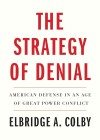American Defense in an Age of Great Power Conflict
by Elbridge A. Colby
Yale University Press, 2021. pp 384
Hardcover ISBN: 0300256434
Paperback ISBN: 0300268025
Reviewed By: Courtney Stewart
Since its 2021 release, Elbridge Colby’s The Strategy of Denial remains a critical contribution to defence strategists grappling with the evolving complexities of China’s growing assertiveness, great power competition in the Indo-Pacific and the role of allies within these dynamics. The Strategy of Denial argues that the most important strategic objective of the United States is to prevent China’s regional hegemony, and thus the strict priority in US defence planning and resourcing should focus on making denial defence a reality in the Indo-Pacific. The book provides a simplifying logic for US strategy underpinned by a conceptual framework and a compelling rationale for why a denial defence strategy most effectively aligns its benefits with the associated costs and risks.[1] However, as Colby contends, its success depends on the United States and its allies committing the requisite level of effort and focus to its implementation.
The central theme of The Strategy of Denial is a case for the adoption of a denial defence strategy in the Indo-Pacific to prevent China’s regional hegemony, with Taiwan as the critical linchpin. Colby critiques the past assumption of China’s peaceful rise and provides a detailed analysis of what he deems as China’s ‘focused and sequential strategy’ as a calculated effort to isolate and coerce individual states to achieve its interests. He identifies Beijing’s expanding power and strategic ambitions—particularly its intent to reclaim Taiwan and assert control over the South China Sea’s nine-dash line—as direct threats to regional stability and the international order. Colby outlines the optimal US response to China’s ‘best’ strategy as being denial defence that seeks to prevent China’s ability to use military force to achieve its political objectives. If China could subjugate Taiwan, it could then lift its gaze to the next likely target, the Philippines.[2] To deter Beijing’s ambitions, the United States must prepare for a potential conflict, ensuring that no state, including China, can achieve hegemony in the Indo-Pacific, by maintaining favourable regional balances of power.
A central tenet of Colby’s argument is that denying hegemony requires a militarily robust league of states sufficiently capable of exerting balancing power through the establishment of an anti-hegemonic coalition. For Colby, this means that the regional balance of power is ultimately about whose military power would prevail in a test of arms. To be effective, the coalition must prevail in a systemic regional war through the achievement of its aims. Colby makes a critical conditional point that is often lost in Australian defence debates—the outcome of such a war will not be determined by the absolute power balance, but will instead involve a contest over which side has the will and way to employ its military to meet its objective.[3] Ultimately, those who prevail will be those who are willing to fight harder and risk more to attain their goal, and who are willing to commit the resolve to denying it to others. For Colby, this means the coalition only requires a shared opposition to an aspiring hegemon’s bid for predominance as the common incentive to bind their unity.
Colby’s framework necessitates that the United States serves as the ‘cornerstone balancer’ of the coalition and that middle powers like Australia and Japan function primarily as key contributors to the broader strategic goals. That is, allies support the denial of a swift, fait accompli-style occupation of Taiwan or, alternatively, participate in the ejection of the invading forces before they can consolidate their hold on it. Herein lies the obvious preference to deter before the necessity of having to fight a limited war and the start of Chinese regional hegemony. Colby makes a case for relieving the political risk on coalition members’ participation in any denial defence strategy, articulated as ‘differentiated credibility’, as a heightened US commitment to defending its regional alliances in the Indo-Pacific as a priority, while emphasising other less critical regions. While Australia may be given such US commitments, these may have little impact on the (often) misalignment between its official diplomatic and military positions on China. When the time comes to act, such misalignment would likely weaken Australia’s ability to generate the level of political resolve and the higher risk tolerance needed to effectively support participation in a potential anti-hegemonic coalition.
While Colby’s emphasis on denial defence is pragmatic, it underestimates the political and economic complexities of sustaining a coalition in the face of potential divergent national interests. It also assumes a level of interoperability and cohesion that such a coalition would need to be operationally effective, and that would inevitability impact the adversary’s perception as to the effectiveness of coalition deterrence efforts.[4] Additionally, his limited war framework, while logical, may be overly optimistic in assuming rational escalation management—by both sides. These points raise important questions for Australian policymakers and planners. For example, how could Australia assert its agency within the coalition, ensuring its own strategic priorities are not subsumed by Washington’s broader agenda? For Australia, Colby’s approach to Taiwan raises strategic dilemmas. While defending Taiwan may be critical to preserving long-term regional stability and strategic balance of power, whether Taiwan is the linchpin of regional security is contestable. In the near-term, an Australian decision to commit forces to such a scenario would carry substantial operational and political risk are, given its geographic distance and limited ability to project power into a Taiwan theatre. This would leave Australia exposed and highly reliant on America’s aforementioned commitment to defend it.
The Strategy of Denial is a worthy read for two reasons. First, irrespective of whether the reader intellectually plunges into Colby’s worldview and strategic logic, or remains a sceptic, the book delivers a lucid and disciplined structure towards defence strategy and prioritisation of threats, interests, and resources. Colby’s emphasis on denial defence would resonate strongly with those implementing Australia’s 2024 National Defence Strategy (NDS). This book invites Australian defence thinkers to engage deeply with American strategic perspectives, fostering a more thoughtful evaluation of how Australia can shape its strategic environment, align its interests, and strengthen its resolve within a coalition-based denial defence framework. The Strategy of Denial should be required reading among those contributing to the 2026 NDS. For policymakers, military planners, and defence scholars, Colby’s book serves as a lens to evaluate how US leadership might navigate great power competition and recalibrate its commitments through a realist framework.
Finally, Elbridge Colby was the former Deputy Assistant Secretary of Defense for Strategy and Force Development in the first Donald Trump administration, and the lead architect of the US 2018 National Defense Strategy. In many ways, The Strategy of Denial serves as an extended version of this concise 11-page document. Colby was nominated on day one of President Trump’s second term for the third highest position in the Pentagon, Under Secretary of Defense for Policy. He is currently awaiting confirmation from the Senate Armed Services Committee. Thus, The Strategy of Denial offers valuable insights into the strategic and geopolitical perspective of a key decision-maker of future US defence strategy and policy as well as the Alliance.
Endnotes
[1] Elbridge A. Colby, Strategy of Denial: American Defence in an Age of Great Power Conflict (New Haven: Yale University Press, 2001), p. 236
[2] Ibid, pgs 116-117
[3] Ibid, p. 18
[4] Courtney Stewart, Think Bigger, Act Larger: A U.S.-Australia Led Coalition for a Combined Joint Deterrence Force in the Indo-Pacific, Carnegie Endowment for International Peace, October 2, 2024: https://carnegieendowment.org/research/2024/10/us-australia-led-coalition-for-a-combined-joint-deterrence-force-in-the-indo-pacific?lang=en.



